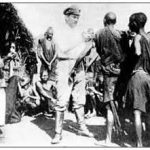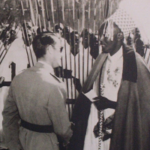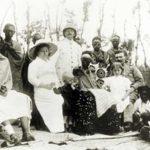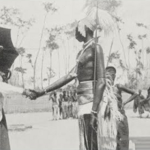Revival Of Kin-Group Status
Although lineages gradually lost their corporate and political functions, they continued to serve as an important medium for social identification and, to judge from later events, kinship linkages retained their organizational potential.When alternatives became available through socio-economic change, younger members of formerly powerful and prestigious lineages (often Hutu) wouldtry to escape clientship, and the exactions of the chiefs, by seeking wage work from Europeans. Such young men chafed with memories of past glory, when their fathers or grandfathers had been leaders of wealthy and politically autonomous lineages, free from the harassment which came to be a byword of Tuutsi rule in Rwanda. In breaking out of the local authority system, they gained acquaintance with new ideas and skills which latex proved useful for mounting protests against the system; but besides the new skills, these Hutu leaders manipulated ties to mobilize followings, stressing particularly the past prestige associated with their lineages.
The emergence of organized protest was facilitated by three more factors. First was a broadening of kinship concepts. Changes introduced by central government policy, the spread of Christianity, and the effects of socio-economic forces appear to have encouraged an expansion of the “kinship universe” of Kinyagans. Through clientship ties, for example, a person came into contact with others of different lineages, who were clients of the same patron. Such contacts may have served as a basis for the formation of new groupings which borrowed kinship terminology in the regulation of relations among the participants. A similar process can be hypothesized for contacts among persons working for wages, or even for those who felt victim to corvée. Their collective subordination to the goals and interests of the chiefs provided them with a common structural status which cut across occupational, kin, or geographical differences. The broadening of horizons through shared experience may well have contributed to the emergence of pan-Hutu cohesion in the 1950s.
A second and related factor was the ethnic discrimination implicit in the extension of central government control at the expense of local lineage groups. Before the introduction of central administration under Rwabugiri, lineage heads in tire region enjoyed status and prestige as representatives of their kin groups. This role was significant for both Hutu and Tuutsi lineages, so that there was extensive participation by Hutu in local affairs. When hill chiefs were introduced, lineage heads lost many of their former prerogatives, and saw the corporate character of their kin groups weakened.
Alternatives to the former prestige of lineage leadership existed for some Tuutsi in the form of appointment to political office or jobs in the colonial administration. But this alternative was virtually inoperative for Hutu from the 1920s, as European policies expanded and entrenched Tuutsi predominance. Where Hutu retained any participation in the administration, this was only as ibirongozi, the subordinates of hill chiefs, or (occasionally) as lowly clerks. Ibirongozi performed particularly unpopular functions for the hillchiefs, such as extracting prestations, services, and taxes from the population.
Finally, the life chances of most Hutu were further restricted by the discrimination introduced in the Catholic schools (by far the largest educational system throughout the colonial period). Beginning in 1926, Tuutsi who previously had resisted conversion began to flock to the Catholic missions seeking instruction. The bishop at the time, Mgr. Léon Classe, saw this as an opportunity to strengthen the political role of the Church in Rwanda, and to create an ethnically defined Christian “aristocracy” composed of Tuutsi.Therefore to accommodate and further encourage this trend the Church adjusted its educational policies and introduced overt discrimination, favofing Tuutsi and discriminating against Hutu. While Hutu would also receive education, this would be shaped and constrained to fit the status Mgr. Classe envisaged for them: “they will take up places in mine-working and industry.” By the end of 1928 the explicit guidelines issued by Mgr. Classe had resulted in clear discrimination against Hutu in most of Rwanda’s Catholic mission schools, including Mibirizi Mission in Kinyaga.
At Save Mission near Astrida, for example, Tuutsi and Hutu pupils studied many of the same subjects, but only Tuutsi received special additional instruction in skills useful for maintaining records in a chief-dom, and in the French language. At Kansi, another Mission in the Astrida area, Tuutsi pupils received French instruction while Hutu did not, and Hutu children often missed school because of the heavy corvées they were required to perform in the subchiefdoms. Thus, as Mbonimana emphasizes, a form of segregation in the Catholic mission schools paralleled (if perhaps in milder form) the discrimination found
in the Groupe Scolaire d’Astrida, the only government school in the country.
The Groupe Scolaire, which enrolled its first students in 1932, replaced the earlier Ecole des Fils des Chefs (also called the Ecole des Batutsi) located in Nyanza. It was administered and staffed by an order of Catholic brothers, Les Frères de la Charité, but funded by the colonial government. One of the goals of this school was to create a “new social class,” and in accordance with this goal (and the concerns of Mgr. Classe) very few Hutu were admitted; indeed, until after World War II the school even had a minimum height requirement for admission. Graduates of the Groupe Scolaire considered themselves superior to other educated Rwandans (e.g., those, many of them Hutu, who had obtained post-primary education in the Catholic seminaries), and their diplomas were accorded greater value by the Belgian administration. Thus, in theory because of their professional qualifications but in reality because they were overwhelmingly drawn from among the families of Tuutsi chiefs, the graduates of the Groupe Scolaire enjoyed the benefits of both the “traditional” economic structures, and of the higher status jobs and better pay available in the “modern” sector. Such changes in the government structures and educational system represented a marked reduction in status for Hutu, and introduced a more marked stratification between ethnic groups than had existed in the past. And as stratification was intensified, ethnic distinctions were sharpened. In this sense, ethnic discrimination was a corollary to the reduction in kin group autonomy, while the collective subordination of this ethnically defined group contributed to the emergence of a broader identity. The state successfully weakened the perceived threat of one kind of corporate group, the property-owning lineage, while the state and the Catholic Church encouraged the creation of a new Christian “ruling class,” to be composed exclusively of Tuutsi.These processes helped to foster the emergence of a new and broader identity group (Hutu) based on the resentments of the dispossessed
https://uk.amateka.net/revival-of-kin-group-status/https://uk.amateka.net/wp-content/uploads/2020/07/gisabo.jpghttps://uk.amateka.net/wp-content/uploads/2020/07/gisabo-150x150.jpgChanges and ColonialismAlthough lineages gradually lost their corporate and political functions, they continued to serve as an important medium for social identification and, to judge from later events, kinship linkages retained their organizational potential.When alternatives became available through socio-economic change, younger members of formerly powerful and prestigious lineages (often Hutu) wouldtry...BarataBarata rpierre@ikaze.netAdministratorAMATEKA | HISTORY OF RWANDA




